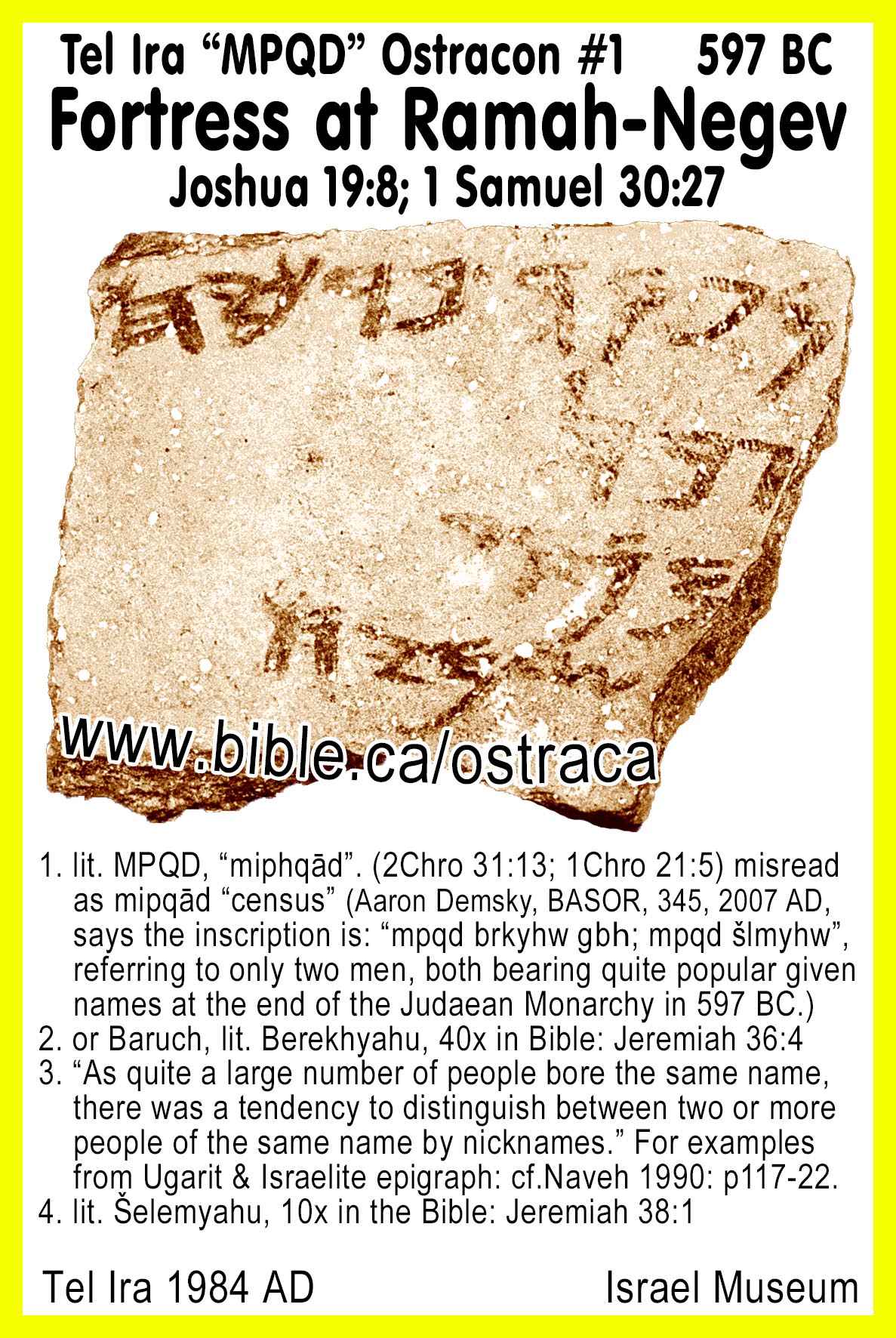Ostraca, Tablets and Inscriptions of the Bible
|
Arad Letters |
Ramah-Negev is a late bronze city that dates back to the time of Joshua. Ira ostraca #1 was discovered in 1984 AD this ostraca references two army troop commanders at a time (597 BC) when the Edomites were invading the Negev. |
|
|
Ira Ostraca collection |
|
|
|
"This paper proposes that the inscription should be read: mpqd brkyhw gbḥ; mpqd šlmyhw, referring to only two men, both bearing quite popular given names at the end of the Judaean Monarchy. … My proposal would be to read: mpqd brkyhw gbḥ; mpqd šlmyhw. Following Garfinkel’s view that mpqd means “command” (2 Chron 31:13), the text is translated: “The command of Berekhyahu (the) Bald; The command of Šelemyahu.” The result of this reading is that there are only two men mentioned, both bearing given names that were quite popular at the end of the Monarchy. For that reason, the first person might have had a modifying nickname, “Gibbeaḥ—the bald” (referring to his high forehead—see Lev 13:41). Since there is no definite article before Gibbeaḥ, one might translate his kinnui “Bald Berekhiah.” Being called “Baldy” (qareaḥ) could make some people very angry, as it did the prophet Elisha (2 Kgs 2:23: עלה קרח עלה קרח “Go away, Baldy; go away Baldy”). However, it could be a nickname of endearment, as was the case when Ben Azzai referred to his mentor and friend Rabbi Akiba as “this bald one” (TB Bekhorot 58a). Of course, this suggests that having a double name with some physical attribute—a practice found in late Second Temple times—was already established at this early period." (The MPQD Ostracon from Tel ʿIra: A New Reading, Aaron Demsky, BASOR 345, 2007 AD) |
Fortress at Ramah-Negev
Tel Ira “MPQD” Ostracon #1
Joshua 19:8; 1 Samuel 30:27
Introduction:
- Tel Ira (Ramah-Negev) ostracon #1 was discovered at Tel Ira in 1984 AD
- Ramah-Negev is found in two Bible passages: Joshua 19:8; 1 Samuel 30:27
- "together with all the villages all around these towns as far as Baalath-beer, Ramah of the Negeb. This was the inheritance of the tribe of Simeon according to its families." (Joshua 19:8)
- "it was for those in Bethel, in Ramoth of the Negeb, in Jattir," (1 Samuel 30:27)
I. Translation of Ira ostracon #1
|
“The command1 of Berechiah2 (the) Bald2; The command1 of Shelemiah4” (Steve Rudd translation)
Steve rudd footnotes 1. lit. MPQD, “miphqād”. (2Chro 31:13; 1Chro 21:5) misread as mipqād “census” (Aaron Demsky, BASOR, 345, 2007 AD, says the inscription is: “mpqd brkyhw gbh; mpqd šlmyhw”, referring to only two men, both bearing quite popular given names at the end of the Judaean Monarchy in 597 BC.) 2. or Baruch, lit. Berekhyahu, 40x in Bible: Jeremiah 36:4 3. “As quite a large number of people bore the same name, there was a tendency to distinguish between two or more people of the same name by nicknames.” For examples from Ugarit & Israelite epigraph: cf.Naveh 1990: p117-22. 4. lit. Šelemyahu, 10x in the Bible: Jeremiah 38:1 |
II. The connection of Tel Ira with Arad ostraca #80 and #24:
"The most chilling episode in Eliashib’s career came to light three years after the discovery of the archive in his office. I was supervising the excavation of the slope outside the fortress on the western side. An American volunteer from the University of North Carolina came running over with an inscribed sherd she had just found. It was a letter to Eliashib, but unfortunately only the back side was well preserved. From the script, we could tell that it had come from the stratum VI fortress. It was an order to rush troops from Arad and from neighboring Kinah to strengthen the defenses of Ramah-Negeb (probably Tel ‘Ira, southwest of Arad on a hill overlooking the entire Beer-Sheba Valley): “To Eliashib … king … troop … from Arad 50 and from Kin[ah] … and you shall send them to Ramah-Negeb. … ” The message is stringent—not to say hard-boiled: “The word of the king is incumbent on you for your very life! Behold I have sent to warn you today.” Ramah-Negeb had to be defended, “lest Edom should come there.” When the Edomites to the south and east saw that Judah was under heavy pressure from the Babylonians, the Edomites invaded the Negeb, occupied southern Judah and even cheered when Nebuchadnezzar destroyed Jerusalem (Obadiah 1:10, 14; Psalm 137:7). It was in this probable context that Eliashib was ordered to rush troops from Arad and Kinah for the defense of Ramah-Negeb. This defense probably failed." (Ancient Aramaic and Hebrew Letters, J. M. Lindenberger, Vol. 14, p114, 2003 AD)
Conclusion:
- Tel Ira (Ramah-Negev) ostracon #1 is connected with Arad ostraca #80 and #24
- Ramah-Negev is mentioned twice in the Bible: Joshua 19:8; 1 Samuel 30:27
By Steve Rudd: Contact the author for comments, input or corrections.


